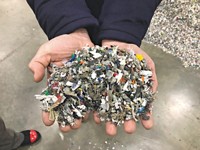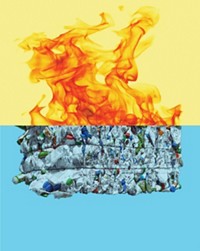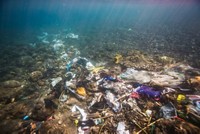Advertisement
Grab your lab coat. Let's get started
Welcome!
Welcome!
Create an account below to get 6 C&EN articles per month, receive newsletters and more - all free.
It seems this is your first time logging in online. Please enter the following information to continue.
As an ACS member you automatically get access to this site. All we need is few more details to create your reading experience.
Not you? Sign in with a different account.
Not you? Sign in with a different account.
ERROR 1
ERROR 1
ERROR 2
ERROR 2
ERROR 2
ERROR 2
ERROR 2
Password and Confirm password must match.
If you have an ACS member number, please enter it here so we can link this account to your membership. (optional)
ERROR 2
ACS values your privacy. By submitting your information, you are gaining access to C&EN and subscribing to our weekly newsletter. We use the information you provide to make your reading experience better, and we will never sell your data to third party members.
Recycling
Ezgi Toraman
This chemical engineer studies technologies that turn waste into fuels, chemicals, and other products
by Matt Blois
May 19, 2023
| A version of this story appeared in
Volume 101, Issue 16

Credit: Courtney Robinson\Will Ludqig\C&EN | Ezgi Toraman
mericans hate carpet. Responding to a clarion call from the hardwood-worshiping hosts of home renovation TV shows, people in the US tear up 1.8 million metric tons of carpet every year and throw it away, according to the US Environmental Protection Agency. Carpet is difficult to recycle because it’s made with multiple types of plastic, so the result of this carnage usually ends up in a landfill—along with the vast majority of the disposable utensils, toothpaste tubes, bandages, sweat-wicking workout clothes, and other plastics used in the US.
Ezgi Toraman sees all that trash as a potential resource. A chemical engineer at the Pennsylvania State University, she studies the fundamental chemistry behind technologies that turn materials normally considered waste into fuel, chemicals, and other products.
Advertisement
One of her projects aims to improve the pyrolysis of plastics, an emerging recycling technology that heats plastics in an unreactive atmosphere to convert them into useful products or feedstock chemicals. While most recycling methods require a homogeneous stream of a single plastic, pyrolysis processes can accept a mixture of plastics, making it a promising option for carpet, multilayer food packaging, and other streams of mixed plastic.
This versatility comes with a challenge, though. Depending on which plastics are fed into the process, pyrolysis can generate thousands of complex reactions and a wide range of end products. Scientists don’t understand those reactions well, so it’s hard to predict which chemicals—only some of them valuable—a given mixture of plastic will produce.
Toraman is using advanced analytical techniques to characterize the reactions that occur during pyrolysis of various combinations of plastics. “We are basically decoding this complexity,” she says. “We are able to understand which polymers are responsible for which reactions.”
Her team includes machine learning experts, catalyst chemists, and researchers who examine the environmental and economic feasibility of recycling. They use information about these reactions to create a model that helps pyrolysis companies tune their processes to make the most valuable products from the specific mix of plastics they are working with. The team is also investigating catalysts that can upgrade the products of pyrolysis into more valuable chemicals, such as benzene, toluene, xylene, and olefins.
“If we have plastic in our lives, we need to find ways to minimize the environmental impact.”
—Ezgi Toraman, professor, Pennsylvania State University
Michael Janik, head of Penn State’s Chemical Engineering Department and a member of Toraman’s team, says this type of research will make plastics recycling much more practical and economical. “When we put our plastics in the recycling bin, we generally don’t separate them,” he says. “It’s challenging to get to a separated, pure waste stream.”
This research flows directly into industry. Last year, Toraman’s pyrolysis project got a $3.4 million grant from Remade, a research consortium funded by private companies and the US Department of Energy that aims to boost the development of recycling technologies. Her team is collaborating with private companies, such as Shaw Industries Group, that sell and recycle carpets.
Some environmentalist groups have criticized pyrolysis as a way for chemical companies to downplay the environmental impacts of plastic pollution, giving them license to continue producing lots of plastic. Groups like Beyond Plastics and the National Resources Defense Council argue that using pyrolysis to turn plastic into fuel means that the carbon from plastic is eventually released into the atmosphere as carbon dioxide and that pyrolysis processes for converting plastic waste into new plastic or chemicals are unproven at large scale. They’d prefer to see companies switch to materials like metal, paper, or glass rather than rely on recycled plastic.
Toraman bristles at those complaints. She points out that plastics are ubiquitous in the modern world. They can’t be easily replaced and won’t go away anytime soon. She sees pyrolysis as one of the most pragmatic ways to reduce the need for new plastic and to prevent existing plastic from polluting the environment. “If we have plastic in our lives, we need to find ways to minimize the environmental impact,” Toraman says.
So she is charging ahead with her research. Toraman is working on a proposal for a Remade-funded project that would create a pyrolysis model that comes even closer to mimicking the behavior of real plastics. Such a project would help make the decarpeting of US homes a bit more sustainable.
Vitals
Current affiliation:
Pennsylvania State University
Age: 35
PhD alma mater:
Ghent University
Hometown:
Ankara, Türkiye
When I’m not doing chemistry, I enjoy:
“Exercising and combining those activities with spending time with my friends and family.”
My role model is:
“Mustafa Kemal Atatürk, founding father of Türkiye. Thanks to his reforms—including but not limited to the reforms to give Turkish women equal rights and opportunities, which were revolutionary for his time and beyond—I grew up in a society where I always felt strong and empowered as a woman.”
Learn more/nominate a rising early-career chemist to be one of C&EN's Talented 12 at:
cenm.ag/t12-nominations-2024
Americans hate carpet. Responding to a clarion call from the hardwood-worshiping hosts of home renovation TV shows, people in the US tear up 1.8 million metric tons of carpet every year and throw it away, according to the US Environmental Protection Agency. Carpet is difficult to recycle because it’s made with multiple types of plastic, so the result of this carnage usually ends up in a landfill—along with the vast majority of the disposable utensils, toothpaste tubes, bandages, sweat-wicking workout clothes, and other plastics used in the US.
Vitals
▸ Current affiliation: Pennsylvania State University
▸ Age: 35
▸ PhD alma mater: Ghent University
▸ Hometown: Ankara, Türkiye
▸ When I’m not doing chemistry, I enjoy: “Exercising and combining those activities with spending time with my friends and family.”
▸ My role model is: “Mustafa Kemal Atatürk, founding father of Türkiye. Thanks to his reforms—including but not limited to the reforms to give Turkish women equal rights and opportunities, which were revolutionary for his time and beyond—I grew up in a society where I always felt strong and empowered as a woman.”
Ezgi Toraman sees all that trash as a potential resource. A chemical engineer at the Pennsylvania State University, she studies the fundamental chemistry behind technologies that turn materials normally considered waste into fuel, chemicals, and other products.
One of her projects aims to improve the pyrolysis of plastics, an emerging recycling technology that heats plastics in an unreactive atmosphere to convert them into useful products or feedstock chemicals. While most recycling methods require a homogeneous stream of a single plastic, pyrolysis processes can accept a mixture of plastics, making it a promising option for carpet, multilayer food packaging, and other streams of mixed plastic.
This versatility comes with a challenge, though. Depending on which plastics are fed into the process, pyrolysis can generate thousands of complex reactions and a wide range of end products. Scientists don’t understand those reactions well, so it’s hard to predict which chemicals—only some of them valuable—a given mixture of plastic will produce.
Toraman is using advanced analytical techniques to characterize the reactions that occur during pyrolysis of various combinations of plastics. “We are basically decoding this complexity,” she says. “We are able to understand which polymers are responsible for which reactions.”
Her team includes machine learning experts, catalyst chemists, and researchers who examine the environmental and economic feasibility of recycling. They use information about these reactions to create a model that helps pyrolysis companies tune their processes to make the most valuable products from the specific mix of plastics they are working with. The team is also investigating catalysts that can upgrade the products of pyrolysis into more valuable chemicals, such as benzene, toluene, xylene, and olefins.
Michael Janik, head of Penn State’s Chemical Engineering Department and a member of Toraman’s team, says this type of research will make plastics recycling much more practical and economical. “When we put our plastics in the recycling bin, we generally don’t separate them,” he says. “It’s challenging to get to a separated, pure waste stream.”
This research flows directly into industry. Last year, Toraman’s pyrolysis project got a $3.4 million grant from Remade, a research consortium funded by private companies and the US Department of Energy that aims to boost the development of recycling technologies. Her team is collaborating with private companies, such as Shaw Industries Group, that sell and recycle carpets.
Some environmentalist groups have criticized pyrolysis as a way for chemical companies to downplay the environmental impacts of plastic pollution, giving them license to continue producing lots of plastic. Groups like Beyond Plastics and the National Resources Defense Council argue that using pyrolysis to turn plastic into fuel means that the carbon from plastic is eventually released into the atmosphere as carbon dioxide and that pyrolysis processes for converting plastic waste into new plastic or chemicals are unproven at large scale. They’d prefer to see companies switch to materials like metal, paper, or glass rather than rely on recycled plastic.
Toraman bristles at those complaints. She points out that plastics are ubiquitous in the modern world. They can’t be easily replaced and won’t go away anytime soon. She sees pyrolysis as one of the most pragmatic ways to reduce the need for new plastic and to prevent existing plastic from polluting the environment. “If we have plastic in our lives, we need to find ways to minimize the environmental impact,” Toraman says.
So she is charging ahead with her research. Toraman is working on a proposal for a Remade-funded project that would create a pyrolysis model that comes even closer to mimicking the behavior of real plastics. Such a project would help make the decarpeting of US homes a bit more sustainable.



















Join the conversation
Contact the reporter
Submit a Letter to the Editor for publication
Engage with us on Twitter